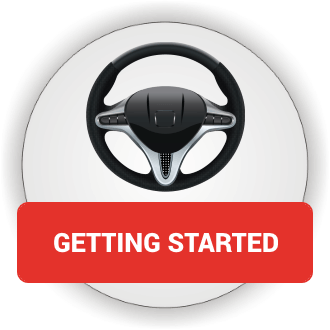Practical Test
Practical Driving Test - Preparation
The practical test is about making sure that those assessed reach the required standard of driving skills. Before you take it, and even before you book it, you will have to take and pass the theory and hazard perception test.
Traditionally, you will have a driving lesson an hour before taking your practical test. This is always a good idea, as it gives you a chance to settle into the car and run through any points you are concerned about. This lesson is not used as a teaching element, which is why you should be at the required standard prior to this time.
What Happens in your Test
At the start of the practical test, the examiner will come out and call your name. You will then be asked to read and sign the insurance and residency declarations while the examiner inspects your documentation. If all is in order, you will then be asked to walk to your car.
You will also be asked if you wish your trainer to be present on the driving test, and if you would like them there at the end of the test for the de-brief. This is entirely your decision and worth discussing well before taking the test.
Eyesight Test
Before getting to your car, the examiner will ask you to stop and read a new style number plate at a 20m or an old-style number plate at a distance of 20.5m. If you fail to do this, the exam will go no further, you will fail.
Show Me and Tell Me Questions
At the car, the examiner will ask you two questions from the show and tell question bank. Fail to answer either question correctly and you will score one minor fault.
The Driving Part of the Practical Test
The examiner will now ask you to get into the car and prepare yourself for the driving part of the practical test. Get in and perform a brief cockpit drill. As you have used the car to drive to the test centre, the examiner won’t expect you to alter anything but they will expect you to make a visual check to make sure everything is as it should be. Don’t forget to put your seat belt on.
The examiner will then give you the following instructions:
‘During the test I would like you to follow the road ahead at all times, unless signs or markings indicate otherwise, or I ask you to make a turn, which I will do in good time. When you are ready, move off.’
You should now start the engine and move off. To be successful and to pass, you must drive safely and demonstrate through your driving that you have a sound knowledge of the Highway Code. Don’t worry if you make a mistake, keep calm and continue driving. Unless you make a serious or dangerous fault, or make a less serious mistake a number of times, you won’t fail the practical test.
The duration of the test will be up to 40 minutes and will cover a variety of roads and traffic situation. You will have to deal with roundabouts, crossroads, pedestrian crossings and where possible dual carriageways, rural and residential roads. Test centre’s do have specific routes that they follow, but these routes are designed to include the widest range of driving possible in that area, and to give a consistent standard of testing across the whole country.
You will have to perform at least one manoeuvre: Parallel parking, Bay parking – driving in or reversing in, Pulling up on the right-hand side of the road. You may also have to perform an emergency stop.
If you come to a junction or roundabout and the examiner gives you no instruction, you must follow the road ahead, for example go straight ahead at a roundabout. If the examiner gives you an instruction which you are unsure about, ask them to repeat it.
The practical now includes a section called independent driving. Its aim is to assess a candidate’s ability to make their own decisions whilst driving.
In Order to Pass the Test, You Must Drive:
- Without committing any serious or dangerous faults
- Without committing more than 15 driving errors of a less serious nature.
Dangerous Driving Faults – a fault that results in actual danger. Commit such a fault and you will fail the practical test.
Serious Driving Faults – is when a potentially dangerous incident occurs, when the candidate reveals a recurring driving fault or fails to perform a reversing manoeuvre correctly. Receive a serious fault and you fail the practical test.
Minor Driving Faults – less serious faults, such as hesitating too long at a junction, faults that don’t provide any immediate danger. Receive 16 or more minor driving faults and you will fail the practical test.



